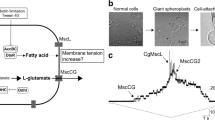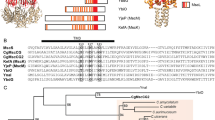Abstract
Corynebacterium glutamicum has been utilized for industrial amino acid production, especially for monosodium glutamate (MSG), the food-additive for the “UMAMI” category of taste sensation, which is one of the five human basic tastes. Glutamate export from these cells is facilitated by the opening of mechanosensitive channels in the cell membrane within the bacterial cell envelope following specific treatments, such as biotin limitation, addition of Tween 40 or penicillin. A long-unsolved puzzle still remains how and why C. glutamicum mechanosensitive channels are activated by these treatments to export glutamate. Unlike mechanosensitive channels in other bacteria, these channels are not simply osmotic safety valves that prevent these bacteria from bursting upon a hypo-osmotic shock. They also function as metabolic valves to continuously release glutamate as components of a pump-and-leak mechanism regulating the cellular turgor pressure. Recent studies have demonstrated that the opening of the mechanosensitive channel, MscCG, mainly facilitates the efflux of glutamate and not of other amino acids and that the “force-from-lipids” gating mechanism of channels also applies to the MscCG channel. The bacterial types of mechanosensitive channels are found in cell-walled organisms from bacteria to land plants, where their physiological functions have been specialized beyond their basic function in bacterial osmoregulation. In the case of the C. glutamicum MscCG channels, they have evolved to function as specialized glutamate exporters.





Similar content being viewed by others
References
Anishkin A, Kamaraju K, Sukharev S (2008) Mechanosensitive channel MscS in the open state: modeling of the transition, explicit simulations, and experimental measurements of conductance. J Gen Physiol 132(1):67–83
Bass RB, Strop P, Barclay M, Rees DC (2002) Crystal structure of Escherichia coli MscS, a voltage-modulated and mechanosensitive channel. Science 298(5598):1582–1587
Bavi N et al (2014) Biophysical implications of lipid bilayer rheometry for mechanosensitive channels. Proc Natl Acad Sci U S A 111(38):13864–13869
Bavi N et al (2016) The role of MscL amphipathic N terminus indicates a blueprint for bilayer mediated gating of mechanosensitive channels. Nat Commun 7:11984
Becker M, Krämer R (2015) MscCG from Corynebacterium glutamicum: functional significance of the C-terminal domain. Eur Biophys J 44(7):577–588
Becker M et al (2013) Glutamate efflux mediated by Corynebacterium glutamicum MscCG, Escherichia coli MscS, and their derivatives. Biochim Biophys Acta 1828(4):1230–1240
Bialecka-Fornal M, Lee HJ, Phillips R (2015) The rate of osmotic downshock determines the survival probability of bacterial mechanosensitive channel mutants. J Bacteriol 197(1):231–237
Börngen K et al (2010) The properties and contribution of the Corynebacterium glutamicum MscS variant to fine-tuning of osmotic adaptation. Biochim Biophys Acta 1798(11):2141–2149
Cantor RS (1999) Lipid composition and the lateral pressure profile in bilayers. Biophys J 76(5):2625–2639
Chang G, Spencer RH, Lee AT, Barclay MT, Rees DC (1998) Structure of the MscL homolog from Mycobacterium tuberculosis: a gated mechanosensitive ion channel. Science 282(5397):2220–2226
Cox CD, Bavi N, Martinac B (2018) Bacterial Mechanosensors. Annu Rev Physiol 80:71–93
Hamilton ES, Haswell ES (2017) The tension-sensitive ion transport activity of MSL8 is critical for its function in pollen hydration and germination. Plant Cell Physiol 58(7):1222–1237
Hasegawa T, Hashimoto K-I, Kawasaki H, Nakamatsu T (2008) Changes in enzyme activities at the pyruvate node in glutamate-overproducing Corynebacterium glutamicum. J Biosci Bioeng 105(1):12–19
Hashimoto K et al (2010) The protein encoded by NCgl1221 in Corynebacterium glutamicum functions as a mechanosensitive channel. Biosci Biotechnol Biochem 74(12):2546–2549
Hashimoto K et al (2012) Glutamate is excreted across the cytoplasmic membrane through the NCgl1221 channel of Corynebacterium glutamicum by passive diffusion. Biosci Biotechnol Biochem 31 76(7):1422–1424
Haswell ES, Meyerowitz EM (2006) MscS-like proteins control plastid size and shape in Arabidopsis thaliana. Curr Biol 16(1):1–11
Haswell ES, Peyronnet R, Barbier-Brygoo H, Meyerowitz EM, Frachisse JM (2008) Two MscS homologs provide mechanosensitive channel activities in the Arabidopsis root. Curr Biol 18(10):730–734
Hirasawa T, Saito M, Yoshikawa K, Furusawa C, Shmizu H (2018) Integrated analysis of the transcriptome and metabolome of Corynebacterium glutamicum during penicillin-induced glutamic acid production. Biotechnol J 13(5):e1700612
Hoischen C, Krämer R (1990) Membrane alteration is necessary but not sufficient for effective glutamate secretion in Corynebacterium glutamicum. J Bacteriol 172(6):3409–3416
Kawahara Y, Takahashi-Fuke K, Shimizu E, Nakamatsu T, Nakamori S (1997) Relationship between the glutamate production and the activity of 2-oxoglutarate dehydrogenase in Brevibacterium lactofermentum. Biosci Biotechnol Biochem 61(7):1109–1112
Kimura E, Abe C, Kawahara Y, Nakamatsu T (1996) Molecular cloning of a novel gene, dtsR, which rescues the detergent sensitivity of a mutant derived from Brevibacterium lactofermentum. Biosci Biotechnol Biochem 60(10):1565–1570
Kimura E, Abe C, Kawahara Y, Nakamatsu T, Tokuda H (1997) A dtsR gene-disrupted mutant of Brevibacterium lactofermentum requires fatty acids for growth and efficiently produces L-glutamate in the presence of an excess of biotin. Biochem Biophys Res Commun 234(1):157–161
Kimura E et al (1999) Glutamate overproduction in Corynebacterium glutamicum triggered by a decrease in the level of a complex comprising DtsR and a biotin-containing subunit. Biosci Biotechnol Biochem 63(7):1274–1278
Kinoshita S, Udaka S, Shimono M (1957) Studies on the amino acid fermentation on the various microorganism. J Gen Appl Microbiol 3(3):193–205
Krämer R (2009) Osmosensing and osmosignaling in Corynebacterium glutamicum. Amino Acids 37(3):487–497
Laneelle MA, Tropis M, Daffe M (2013) Current knowledge on mycolic acids in Corynebacterium glutamicum and their relevance for biotechnological processes. Appl Microbiol Biotechnol 97(23):9923–9930
Levina N, Totemeyer S, Stokes NR, Louis P, Jones MA, Booth IR (1999) Protection of Escherichia coli cells against extreme turgor by activation of MscS and MscL mechanosensitive channels: identification of genes required for MscS activity. EMBO J 18(7):1730–1737
Malcolm HR, Maurer JA (2012) The mechanosensitive channel of small conductance (MscS) superfamily: not just mechanosensitive channels anymore. Chembiochem 13(14):2037–2043
Malcolm HR, Blount P, Maurer JA (2015) The mechanosensitive channel of small conductance (MscS) functions as a Jack-in-the box. Biochim Biophys Acta 1848:159–166
Martinac B, Buechner M, Delcour AH, Adler J, Kung C (1987) Pressure-sensitive ion channel in Escherichia coli. Proc Natl Acad Sci U S A 84(8):2297–2301
Martinac B, Adler J, & Kung C (1990) Mechanosensitive ion channels of E. coli activated by amphipaths Nature 348(6298):261–263
Martinac B et al (2010) Studying mechanosensitive ion channels using liposomes. Methods Mol Biol 606:31–53
Martinac B, Rohde PR, Cranfield CG, Nomura T (2013) Patch clamp electrophysiology for the study of bacterial ion channels in giant spheroplasts of E. coli. Methods Mol Biol 966:367–380
Martinac AD, Bavi N, Bavi O, Martinac B (2017) Pulling MscL open via N-terminal and TM1 helices: a computational study towards engineering an MscL nanovalve. PLoS One 12(8):e0183822
Murthy SE, Dubin AE, Patapoutian A (2017) Piezos thrive under pressure: mechanically activated ion channels in health and disease. Nat Rev Mol Cell Biol 18(12):771–783
Nakamura J, Hirano S, Ito H, Wachi M (2007) Mutations of the Corynebacterium glutamicum NCgl1221 gene, encoding a mechanosensitive channel homolog, induce L-glutamic acid production. Appl Environ Microbiol 73(14):4491–4498
Nakayama Y, Fujiu K, Sokabe M, Yoshimura K (2007) Molecular and electrophysiological characterization of a mechanosensitive channel expressed in the chloroplasts of Chlamydomonas. Proc Natl Acad Sci U S A 104(14):5883–5888
Nakayama Y, Yoshimura K, Iida H (2012a) Organellar mechanosensitive 1 channels in fission yeast regulate the hypo-osmotic shock response. Nat Commun 3:1020
Nakayama Y, Yoshimura K, Iida H (2012b) A gain-of-function mutation in gating of Corynebacterium glutamicum NCgl1221 causes constitutive glutamate secretion. Appl Environ Microbiol 78(15):5432–5434
Nakayama Y, Yoshimura K, Iida H (2013) Electrophysiological characterization of the mechanosensitive channel MscCG in Corynebacterium glutamicum. Biophys J 105(6):1366–1375
Nakayama Y, Hirata A, Iida H (2014) Mechanosensitive channels Msy1 and Msy2 are required for maintaining organelle integrity upon hypoosmotic shock in Schizosaccharomyces pombe. FEMS Yeast Res 14(6):992–994
Nakayama Y, Komazawa K, Bavi N, Hashimoto K, Kawasaki H, Martinac B (2018) Evolutionary specialization of MscCG, an MscS-like mechanosensitive channel, in amino acid transport in Corynebacterium glutamicum. Sci Rep 27;8(1):12893. https://doi.org/10.1038/s41598-018-31219-6
Nara T, Samejima H, Kinoshita S (1964) Effect of penicillin on amino acid fermentation. Agric Biol Chem 28(2):120–124
Nomura T et al (2012) Differential effects of lipids and lyso-lipids on the mechanosensitivity of the mechanosensitive channels MscL and MscS. Proc Natl Acad Sci U S A 109(22):8770–8775
Nottebrock D, Meyer U, Kramer R, Morbach S (2003) Molecular and biochemical characterization of mechanosensitive channels in Corynebacterium glutamicum. FEMS Microbiol Lett 218(2):305–309
Pivetti CD et al (2003) Two families of mechanosensitive channel proteins. Microbiol Mol Biol Rev 44 67(1):66–85
Pliotas C et al (2015) The role of lipids in mechanosensation. Nat Struct Mol Biol 22(12):991–998
Radmacher E et al (2005) Ethambutol, a cell wall inhibitor of Mycobacterium tuberculosis, elicits L glutamate efflux of Corynebacterium glutamicum. Microbiology 151(Pt 5):1359–1368
Ridone P, Nakayama Y, Martinac B, Battle AR (2015) Patch clamp 1 characterization of the effect of cardiolipin on MscS of E. coli. Eur Biophys J 44(7):567–576
Ridone P et al (2018) “Force-from-lipids” gating of mechanosensitive channels modulated by PUFAs. J Mech Behav Biomed Mater 79:158–167
Rosholm KR et al (2017) Activation of the mechanosensitive ion channel MscL by mechanical stimulation of supported droplet-hydrogel bilayers. Sci Rep 7:45180
Ruffert S, Lambert C, Peter H, Wendisch VF, Krämer R (1997) Efflux of compatible solutes in Corynebacterium glutamicum mediated by osmoregulated channel activity. Eur J Biochem 247(2):572–580
Sawada Y, Sokabe M (2015) Molecular dynamics study on protein-water interplay in the mechanogating of the bacterial mechanosensitive channel MscL. Eur Biophys J 44(7):531–543
Sawada Y, Murase M, Sokabe M (2012) The gating mechanism of the bacterial mechanosensitive channel MscL revealed by molecular dynamics simulations: from tension sensing to channel opening. Channels (Austin) 6(4):317–331
Shiio I, Otsuka SI, Takahashi M (1962) Effect of biotin on the bacterial formation of glutamic acid. I. Glutamate formation and cellular premeability of amino acids. J Biochem 51:56–62
Sotomayor M, Vasquez V, Perozo E, Schulten K (2007) Ion conduction through MscS as determined by electrophysiology and simulation. Biophys J 92(3):886–902
Sukharev SI, Martinac B, Arshavsky VY, Kung C (1993) Two types of mechanosensitive channels in the Escherichia coli cell envelope: solubilization and functional reconstitution. Biophys J 65(1):177–183
Sukharev SI, Blount P, Martinac B, Blattner FR, Kung C (1994) A large-conductance mechanosensitive channel in E. coli encoded by mscL alone Nature 368(6468):265–268
Sun Y, Sun TL, Huang HW (2014) Physical properties of Escherichia coli spheroplast membranes. Biophys J 107(9):2082–2090
Takinami K, Yoshii H, Tsuri H, Okada H (1965) Biochemical effects of fatty acid and its derivatives on L-glutamin acid fermentation. Agric Biol Chem 29(4):351–359
Teng J, Loukin S, Anishkin A, Kung C (2015) The force-from-lipid (FFL) principle of mechanosensitivity, at large and in elements. Pflugers Arch 467(1):27–37
Udaka S (1960) Screening method for microorganisms accumulating metabolites and its use in the isolation of Micrococcus glutamicus. J Bacteriol 79:754–755
Wang Y et al (2018) A novel Corynebacterium glutamicum l-glutamate exporter. Appl Environ Microbiol 84(6)
Wilson ME, Maksaev G, Haswell ES (2013) MscS-like mechanosensitive channels in plants and microbes. Biochemistry 52(34):5708–5722
Zou Y et al (2016) A gain-of-function mutation in Msl10 triggers cell death and wound-induced hyperaccumulation of jasmonic acid in Arabidopsis. J Integr Plant Biol 58(6):600–609
Acknowledgements
We acknowledge the Japanese Society for Promotion of Science (JSPS) for a fellowship to YN, and the National Health and Medical Research Council of Australia for a Principal Research Fellowship to BM.
Author information
Authors and Affiliations
Contributions
Y. N., Y. S., H. K., and B. M. wrote the manuscript.
Corresponding author
Ethics declarations
Funding
This work was supported by the Discovery Project DP180102813 grant from the Australian Research Council.
Conflict of interest
Yoshitaka Nakayama declares that he has no conflicts of interest. Ken-ichi Hashimoto declares that he has no conflicts of interest. Yasuyuki Sawada declares that he has no conflicts of interest. Masahiro Sokabe declares that he has no conflicts of interest. Hisashi Kawasaki declares that he has no conflicts of interest. Boris Martinac declares that he has no conflicts of interest.
Ethical approval
This article does not contain any studies with human participants or animals performed by any of the authors.
Rights and permissions
About this article
Cite this article
Nakayama, Y., Hashimoto, Ki., Sawada, Y. et al. Corynebacterium glutamicum mechanosensitive channels: towards unpuzzling “glutamate efflux” for amino acid production. Biophys Rev 10, 1359–1369 (2018). https://doi.org/10.1007/s12551-018-0452-1
Received:
Accepted:
Published:
Issue Date:
DOI: https://doi.org/10.1007/s12551-018-0452-1




